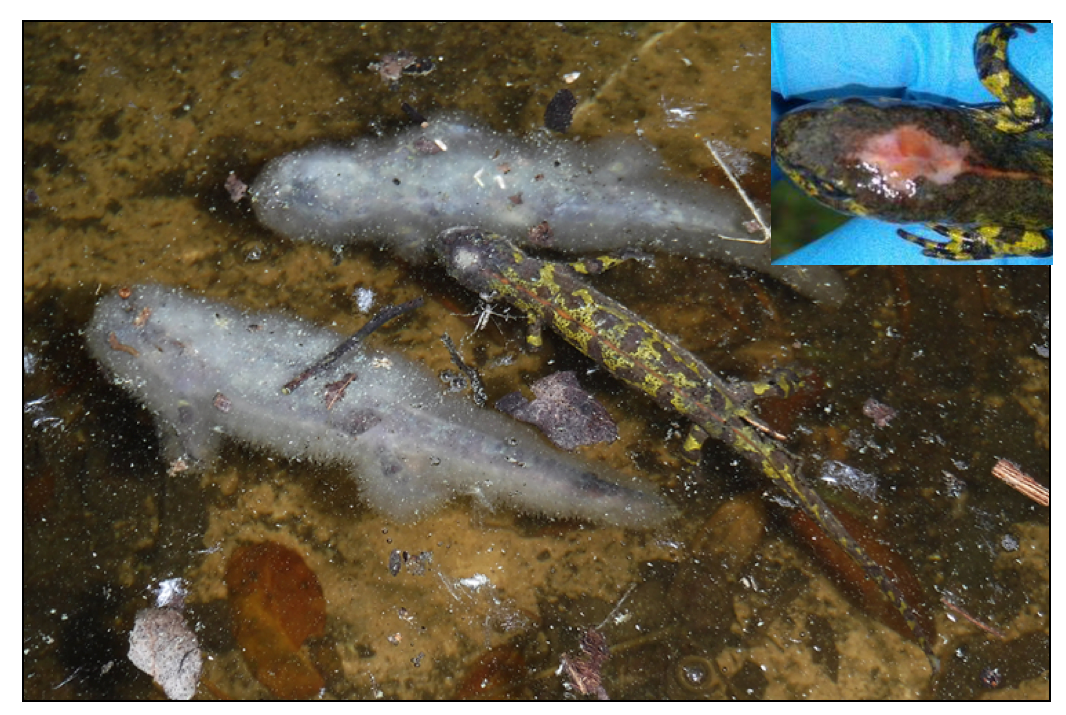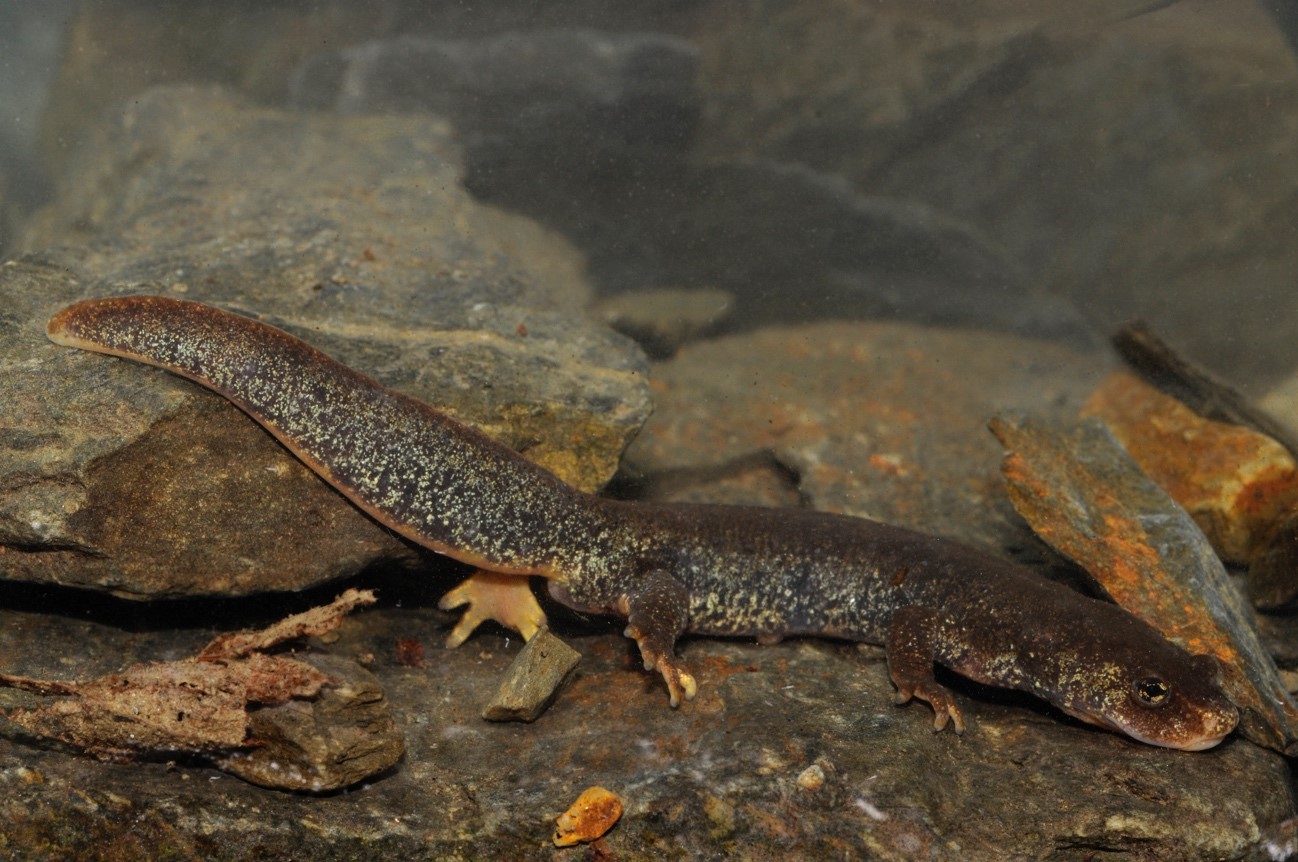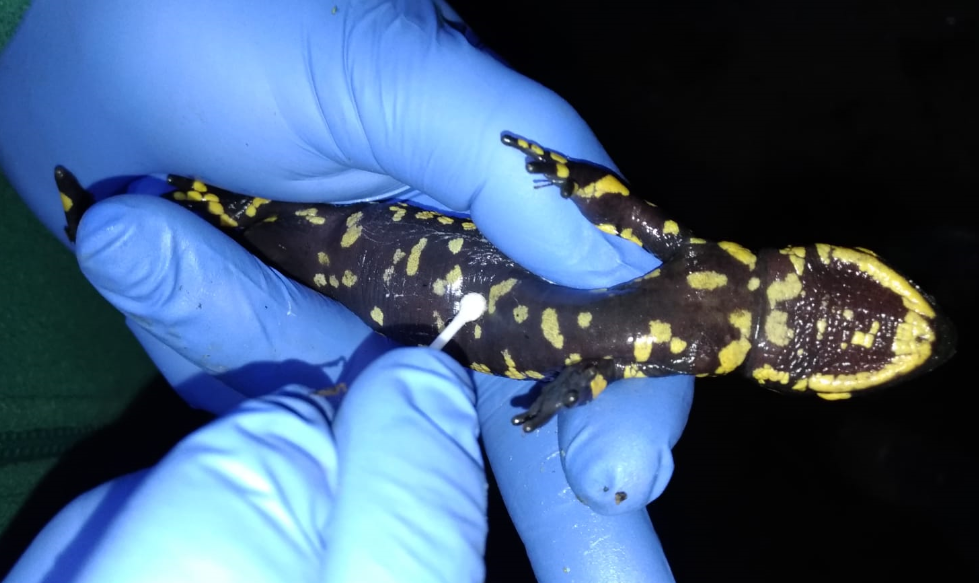IDENTIFICATION AND ISOLATION OF PROBIOTIC BACTERIA TO PROTECT THE CRITICALLY ENDANGERED MONTSENY BROOK NEWT AGAINST CHYTRIDIOMYCOSIS
IDENTIFICATION AND ISOLATION OF PROBIOTIC BACTERIA TO PROTECT THE CRITICALLY ENDANGERED MONTSENY BROOK NEWT AGAINST CHYTRIDIOMYCOSIS
IDENTIFICATION AND ISOLATION OF PROBIOTIC BACTERIA TO PROTECT THE CRITICALLY ENDANGERED MONTSENY BROOK NEWT AGAINST CHYTRIDIOMYCOSIS
IDENTIFICATION AND ISOLATION OF PROBIOTIC BACTERIA TO PROTECT THE CRITICALLY ENDANGERED MONTSENY BROOK NEWT AGAINST CHYTRIDIOMYCOSIS
Funding Body: Universitat Pompeu Fabra
Project Number: Third Call for research projects in the field of Planetary Wellbeing: Montseny Brook Newt Microbiome
Years: 2021-2023
The Amphibian Crisis
Recent studies based on the analysis of 32% of terrestrial vertebrate species indicate that beyond the extinctions that are occurring globally, our planet is experiencing an episode of rapid decline and disappearance of populations known as "biological annihilation". Over the past decades, overexploitation, loss of habitats, the introduction of invasive species, pollution and, more recently, climate change and emerging diseases, have led to a catastrophic decline in the number and size of populations of vertebrate species. As a result, over the last 100 years the extinction of hundreds of species and populations of vertebrates has been verified at a rate 100 times higher than that which had prevailed over the last two million years. An episode that, if not remedied, will undoubtedly have very negative consequences on the ecological functions and the ecosystem services, vital to preserve our planet’s health.
Of all the groups of terrestrial vertebrates, amphibians have been one of those that has received the most attention in the last three decades. Despite being a very deep evolutionary lineage and having survived the last four mass extinctions of our planet, there is evidence that indicates that there is a higher proportion of amphibian species that have already become extinct or are in danger of extinction compared to other vertebrate groups. Amphibians are very sensitive to the loss, degradation and contamination of aquatic and terrestrial environments and to climate change. To these threats, emerging infectious diseases have been added in recent decades. Caused by chytrid fungi (Batrachochytrium dedrobatidis, abbreviated as Bd and B. salamandrivorans abbreviated as Bsal) are responsible for the disease called chytridiomycosis.

Chytridiomycosis has already caused the disappearance of more than 200 species of amphibians around the planet. These diseases, very virulent and with very harmful effects on amphibians, are believed to have been exacerbated by the effects of climate change, globalization, pollution and, above all, by the effect of exotic amphibian species introduced through trade. of legal and illegal species and that act as transmission vectors. Due to all these threats, many amphibian species and populations have been predicted to disappear in the coming years. Of all the amphibian species, it has been seen that those with a higher risk of extinction are mainly those with smaller distributions and fewer populations in mountainous areas that are being transformed as a result of human activity. This situation of population reduction and loss of quantity and quality of habitat, makes these amphibian populations much more susceptible to other threats, including climate change and, above all, infectious diseases caused by chytrid fungi.
The Montseny Brook Newt (Calotriton arnoldi), the only endemic urodele in Spain and the most threatened in Europe
Amphibian diversity is undoubtedly highest in the tropical and subtropical rainforests of Brazil (1,100 species), Colombia (798 species), and Ecuador (641 species). Even so, within Europe, the countries with the greatest diversity of amphibians are Italy (48 species), France (42 species) and Spain (32 species). In fact, if we only look at the number of endemic species, Italy (14 endemic species) and Spain (4 endemic species) are the two European countries with the highest richness of endemic species and, therefore, are very important reservoirs of diversity. The diversity of amphibians in Spain includes stable populations of a total of 22 anurans (2 introduced) and 10 urodeles, of which only the urodele Calotriton arnoldi and the anurans Alytes dickhilleni, A. muletensis and Pelodytes hespericus are endemic. Calotriton arnoldi is the only European amphibian considered Critically Endangered by the IUCN, a category that makes it the most threatened amphibian in Europe. Calotriton arnoldi was described in 2005 from populations that inhabit the Montseny Natural Park (Catalonia).

The Montseny Brook Newt is a fully aquatic amphibian both in its larval and adult. Census data carried out indicate that the number of adult individuals in its entire range is approximately 1,000–1,500. Due to the critical state of the populations at the time of their discovery in 2005, with the presence of numerous threats to their natural habitat that had already caused a decline in populations in previous years, it was considered justified to start an ex-situ breeding program of the species. Thus, in 2007, with the aim of studying and protecting the species, the Generalitat of Catalonia designed the breeding program for C. arnoldi. Thanks to the good results of captive breeding, an experimental program was started in 2010 to establish new populations in favorable habitats, in order to increase the range of the species.
Threats
Many threats to C. arnoldi have been detected that include the extraction of water directly from the streams where the species lives for private use, the overexploitation of aquifers for the massive sale of bottled water, deforestation of the areas close to the newt populations, the risk of fires, and the disruption of the continuity of the streams by the roads and mountain tracks that cross the habitat where the newt lives. Most of these threats are already being solved through conservation programs and other types of actions promoted by the local administration.
Another recent threat linked to climate change that also stalks the Montseny Brook Newt are the already mentioned emerging diseases caused by chytrid fungi. Although to date these diseases have not been detected in C. arnoldi populations, recent studies have confirmed an outbreak of the chytrids Bd and especially Bsal in the Montnegre i el Corredor Natural Park, just 15 Km South of the Montseny massif.
For this reason, emerging diseases have recently become one of the most important threats to the survival of Catalonian urodele populations including C. arnoldi, especially due to the high virulence of Bsal in salamanders and newts. Despite so far the outbreak of Bsal has been successfully contained to the Montnegre i el Corredor Natural Park, the proximity to the Montseny massif and the virulence and spreadabilty of the chytrid require from us to be ready not only to contain a possible outbreak of Bsal in the Montseny massif that could threat C. arnoldi but also to find solutions to cure declining amphibian populations at a global scale.
Bioaugmented probiotics to fight the chytrids
Despite the chytridiomycosis is a vicious and deadly disease for amphibians, it was observed that some individuals of the Mountain yellow-legged Frog (Rana mucosa) in Northern California (USA) were resistant to the disease and these resistant individuals shared a similar microbiota. One of the species reported in the microbial community of the resistant frogs’ skin was Janthinobacterium lividum, a bacterium with known antifungal activity. When J. lividum was inoculated in the skin of Rana mucosa, morbidity and mortality decreased showing that the bacterium was conferring to the frog protection against Bd. Thus, by using bacteria from its own skin scientist have been able to save Rana mucosa from decimation due to the action of the chytrid. This bioaugmentation strategy can represent an effective tool to control chytridiomycosis in nature. Our goal in this project is to find bacterial candidates from C. arnoldi’s skin microbiome that could be used as a probiotic under a similar bioaugmentation strategy to fight Bsal. Having this biological tool at our disposal in advance will provide us some precious time in the unfortunate event of a Bsal outbreak among the fragile populations of the Montseny Brook Newt. This can make the different between preserving or losing this unique endemic amphibian. Furthermore, as a byproduct of our main goal we will pursue as well the obtention of similar probiotics to fight the current Bsal infections affecting other threatened amphibian populations in order to avoid their extirpation in areas such as the Natural Park of Montnegre i el Corredor and other areas in Europe. Because there are no reported cases of Bsal infections in C. arnoldi we will study first the microbiome of the urodele species in the Natural Park of Montnegre i el Corredor that have been already affected by Bsal, the marbled newt Triturus marmoratus and the fire salamander Salamandra salamandra.

We will compare the microbiome of healthy, asymptomatic, and diseased individuals identified using qPCR in order to determine if there is a correlation between their microbiomes and their health statues. The aim is to find specific microbial communities correlated to resistance to Bsal infections. In parallel, we will study the microbiome of C. arnoldi. We will make sure that we analyze representatives of all the subpopulations of C. arnoldi and also ex-situ individuals from the different breeding facilities. In all cases, for each individual we will take three skin swabs, one for the screen of Bsal using qPCR, one for the study of the microbiome though Illumina 16S rRNA amplicon sequencing, and one that we will cryopreserve using culture media and 20% glycerol that we will use for bacterial culturing. We will compare the microbiomes of C. arnoldi with those from T. marmoratus and S. salamandra individuals that appear to be correlated to resistance against disease. Based on the results obtained from this comparison we will recover the frozen samples from C. arnoldi individuals that present microbiomes more similar to those resistant newts and salamanders from the Montnegre i el Corredor. We will use the samples to isolate bacteria in the laboratory in order to create a collection of putative probiotics from the newt’s skin microbiota with potential antifungal activity. We will do that in parallel on T. marmoratus and S. salamandra samples from resistant individuals. This collection of bacterial isolates will be screened in the lab by testing its antifungal activity against Bsal cultures. Those presenting antifungal activity will be cryopreserved for future testing on diseased individuals. In this project we integrate the diverse expertise of the research team that includes conservation, adaptation, population genetics, ecosystem restoration, taxonomy, phylogeny and microbiome to build the tools necessary to protect a critically endangered species against a vicious disease even before it has happened in the system. Despite starting to fight a disease before its appearance might initially sound bold, we need to consider how vicious it is, as chytrid infections have already made 200 amphibian species go extinct, how fragile is the Montseny Brook Newt, and that Bsal is already killing newts and salamander a few kilometers from Calotriton arnoldi’s habitat.
